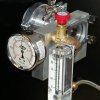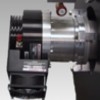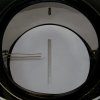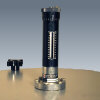| Large 100 mm Vacuum Port |
Our 100 mm vacuum port provides full conductance from the pump to the chamber for better vacuum in the work zone. Smaller pump ports "choke" the flow of gas from the chamber to the pump, resulting in good vacuum readings on a gauge located near the pump, but poorer vacuum in the work zone where the parts are located. |
| Separate Port for Vacuum Gauge |
The vacuum gauge is located on a separate port from the vacuum pump. Since the vacuum pump first removes gas from the chamber, and the chamber then, in effect, sucks gases from the vacuum gauge port, the parts will always be in a better vacuum than what the gauge is indicating. No more seeing a good reading on the vacuum gauge, and then seeing bad parts come out of the furnace later. |
Sight Window Assembly

|
The sight window is designed for quick removal for cleaning. The inert gas flowmeter's compound vacuum and positive pressure dial gauge allows for instant assessment of internal system status. |
| No Right Angle Bend on Pump Port |
Diffusion pumps, which need to be oriented upright, are often connected to vacuum chambers through one or sometimes even two right angle bends. In the molecular flow regime (10-4 torr or lower), a right angle bend will reduce the effective pumping speed by 40-50%. This is because nearly half of the gas molecules which hit the bend are reflected back into the chamber, and only half are reflected down into the pump. Our turbomolecular pump is directly attached to the chamber, with no bends. |
| No Water Cooled or LN2 Cooled Baffle |
Diffusion pumps are usually fitted with water cooled or LN2 cooled baffles to prevent backstreaming of pump oil into the process chamber. These optically dense baffles reduce effective pumping speed by approximately 50%, for the same reason as cited above. A diffusion pump with a rated pumping speed of 150 L/sec will have an effective speed of less than 50 L/sec when the blocking effects of the right angle bend and baffle are accounted for. Our turbomolecular pump does not need a cooled baffle and does not require constant refilling of any LN2 reservoir. |
| No Gate Valve Required |
Because diffusion pumps take a long time to heat up, they should be isolated from the chamber with a high vacuum gate valve. This gate valve reduces effective pumping speed even further and adds to the system complexity and operating difficulty. With a diffusion pump, the gate valve, foreline valve, and roughing valve must all be operated at the right time and in the correct sequence, or oil will backstream into the chamber and the pump can be damaged. Our turbomolecular pump, which reaches full speed in a few minutes, does not require an isolation valve. One simple manual valve is opened to start the pumpdown sequence. When the chamber vacuum reaches the correct level in a few minutes, the turbo pump is turned on by the automatic programmer and no further action is required. |
| Vacuum Port below Hot Zone |
The vacuum port is located in the lower section of the chamber, below the hot zone. The high vacuum pump is not in direct line of sight with the hot zone, so it does not need special protection. Traditional hot zones with 7-8 radiation shields normally operate with their outer layers at 500-700ºC. Since their vacuum ports often are located on the chamber side, the high vacuum pump would be in direct line of sight to the hot outer shield pack and would overheat. Unlike the RED DEVIL™ M, these traditional furnaces require a right angle bend or water cooled baffle to protect the pump. |
Clean Turbomolecular Pump

|
The turbo pump does not have large amounts of oil to backstream into the process chamber, unlike a diffusion pump. It is simpler to operate and maintain and does not require water supply and drain plumbing connections or a constant supply of chilled water. |
| No Water Cooling |
No water cooling is required for either the furnace or pumping system, resulting in substantial savings in installation and operating costs. Furnace operation is greatly simplified, limited essentially to loading the parts, opening the vacuum valve, turning on the turbo pump, and starting the heating program. Traditional furnace operators often fail to properly open and adjust water supply valves to the correct flow in each furnace and pumping system cooling circuit. These valves, which are rarely automated, are often the reason why operators have difficulty starting traditional furnaces, which will not start without water flow. |
| No Flow or Pressure Switches |
Because water cooled furnaces can fail catastrophically if water flow is interrupted, they require flow switches and interlocks which shut down the furnace when water problems occur. This can waste the furnace run and a day's work, often destroying test samples which took much time to prepare. Flow switches often fail in use, shutting down the furnace or preventing startup even when water is flowing. |
| No Backup Water Supply |
Since water cooled furnaces require cooling when operating, it is best to have two independent water supply systems to ensure protection of the equipment, while it takes 1-2 hours to cool down after a water system failure during operation. A city water system is normally used as an emergency backup to the primary tower closed loop cooling system. Complicated and expensive plumbing and valving is needed for automatic transfer from one system to the other. |
| Large Diameter Chamber |
Our 400-mm diameter chamber provides full access for loading and unloading operations. There are no narrow passages or restrictions which can make it difficult to load parts into small diameter chambers. |
Large Diameter Work Zone

|
A 200 mm diameter work zone makes it possible to lay large specimens flat on the hearth plate, preventing creep and distortions which can occur from fixturing parts in vertical orientations. |
| Close Spacing of Top and Bottom Elements |
The top element is located just 100 mm above the bottom element. This close spacing assures uniform heating of the test specimens and prevents any significant "hourglass effect," whereby the outer edges of the work zone at mid height can be substantially cooler in furnaces with elements spaced far apart. |
| Shallow Work Zone for Easy Loading |
The shallow, large diameter work zone simplifies specimen loading and removal. Specially designed load fixtures to lower specimens into tall, narrow work zones are not required. |
| Removable Top Shield Pack
| The top shield pack is mounted on the vacuum chamber lid. Opening the vacuum chamber lid also removes the top shield pack, providing full and unobstructed access to the work zone. |
Retractable Shield Pack

|
The top shield pack is mounted on a linear motion feedthrough to allow opening the hot zone at run completion, providing rapid cooldown capabilities. The bellows sealed motion feedthrough has a manually operated screw drive mechanism for ease of operation and a visual position indicator for positive verification of closed and open positions. |
| Trimmed Heating Elements |
Heating elements are trimmed to provide extra power at the work zone outer edge. This custom design further combats the "hourglass" effect and improves temperature uniformity. |
| Protected Heating Elements |
Heating elements are protected by insulated molybdenum covers. The heating elements are not exposed where they can be hit and damaged during specimen loading and removal. Narrow cylindrical mesh heating elements commonly used in traditional laboratory furnaces are exposed and easily broken, costing thousands of dollars to replace. |
| Pancake Design Heating Elements |
Flat, "pancake" shaped heating elements are thermally efficient. Traditional cylindrical shaped elements located on the work zone outer diameter require 50mm to 100mm larger diameter shield packs, increasing furnace heat losses. Pancake elements are also inexpensive to replace, costing only a few hundred dollars each. |
| Extra Radiation Shields |
Twenty radiation shields are provided. This reduces furnace power consumption and heat loss. Work zone uniformity is also improved because temperature gradients are caused by heat flow. When heat flow is reduced, furnace temperature gradients are reduced as well. |

